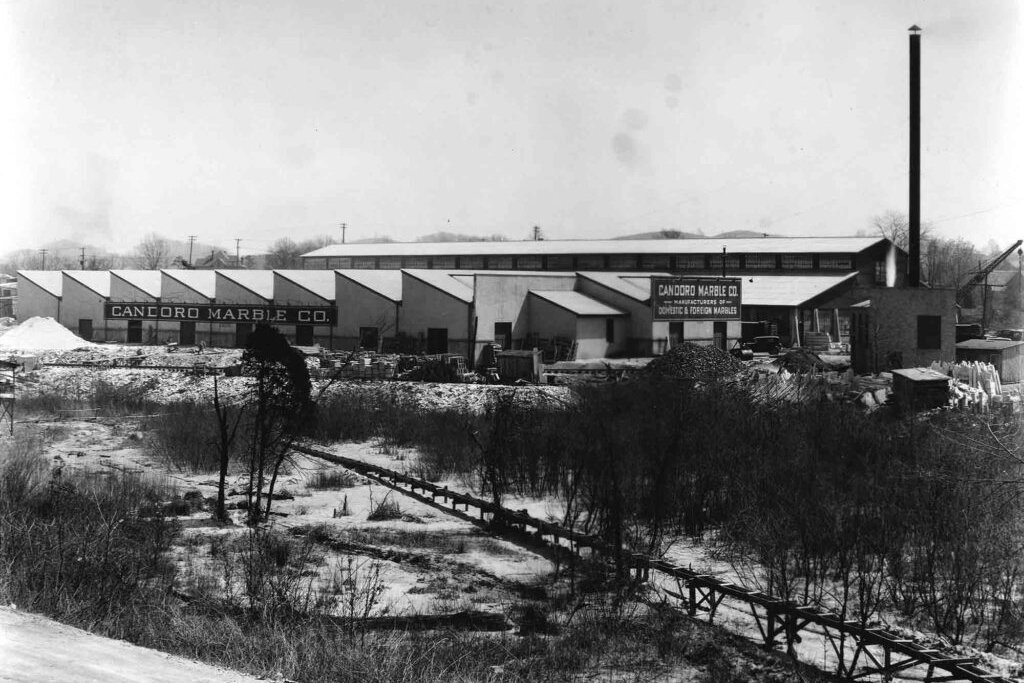
The History of Candoro Marble Company
The marble industry in East Tennessee goes back nearly two hundred years. The stone had been mostly untouched until the early part of the eighteenth century, when it started to be used locally for tombstones, including one for William Blount, the first Governor of Tennessee who died in 1800.
In 1831, Tennessee's first state geologist, Gerard Troost, prepared a survey of the region's mineral deposits. Interest generated by the report led to the creation of the commercial marble industry in 1838, with the founding of Rogersville Marble Company.
East Tennessee marble first attracted national attention in 1848 when two massive blocks from the region were shipped to Washington, D.C., for use in the Washington Monument. Other notable structures featuring East Tennessee marble include Grand Central Station in New York City, as well as the Lincoln Memorial and the National Gallery of Art in Washington, D.C. Local sites showcasing the stone include Knoxville Museum of Art, East Tennessee History Center, the downtown Post Office, Fort Dickerson, Knoxville Botanical Gardens and Arboretum, and Ijams Nature Center.
Candoro Marble Building. Photo courtesy of Barber McMurry Collection, McClung Historical Collection
In 1878, the Craig family of Knoxville formed J.J. Craig & Company and opened its first quarry east of the city. With the rapid growth of the industry, the Candoro Marble Company was established in 1914 by John J. Craig III, F.C. Anderson, W.J. Donaldson, and S.A. Rodgers. The combination of the first letters of each of the founders' surnames makes up the name Candoro. The name is also an allusion to a famous Italian marble called Candora. An annual report initially published by the U.S. Geological Survey, and later by the U.S. Bureau of Mines, shows that the amount of marble produced in Tennessee peaked between 1921 to 1930.
The Candoro Marble Company's office/showroom was designed in the Beaux-Arts style in 1921 by renowned architect Charles Barber. Samuel Yellin, one of the leaders of the American Arts and Crafts Movement, fabricated its exquisite ironwork. Albert Milani, a master sculptor from Carrara, Italy, carved the exterior ornamentation of the building. The company was once the leading producer of finished Tennessee pink marble. Candoro and its neighbor, Vestal Lumber Company, were the largest employers in the area. Candoro alone contracted 140 workers at its peak. However, as Tennessee marble popularity began to wane, the Candoro Marble Company fell onto hard times and shut its doors in 1982. The office/showroom remained primarily empty from the time the company closed. It was added to the National Register of Historic Places in 1996.
This photograph shows the vestibule of the Candoro showroom before restoration efforts began. Original features include the cross-vaulted ceiling and frescoes with floral and geometric motifs.
The entrance to the Candoro Marble Building, with hand-carved floral motif and carved tablet, which was meant to draw the eye upward.
In 2000, a devoted group of volunteers and five angel investors underook to preserve the architectural jewel and make it accessible to the community. The neighborhood volunteers formed a nonprofit called the South Knoxville Arts and Heritage Center, later renamed Candoro Arts and Heritage Center, to protect the building. The structure had suffered neglect and vandalism for numerous years. The nonprofit's group of volunteers stabilized the building and provided programs, many of which centered on the history of marble production in the area. The group's most popular program, Vestival, commenced in 2001 and continues annually, bringing the community together around art, crafts, history, food, and performances. The Candoro Arts and Heritage Center volunteers donated an invaluable amount of time, passion, and dollars towards the building and its programming. In 2014 the goal of buying the building and conducting a major restoration remained unfulfilled, and the Aslan Foundation stepped in to help restore the building to its former glory.
After a long planning phase, including a year of programming discussions with the Candoro Arts and Heritage Center, restoration began in 2019 according to historic preservation standards from the National Park Service. After completion, Tri-Star Arts will make Candoro Marble Building their home including providing artist studios, a gallery, and arts programming. In addition, the Candoro Arts and Heritage Center volunteers will continue to present Vestival as well as quarterly programming.
Learn more about the Aslan Foundation by clicking here.
Because the National Gallery wanted a perfect gradient of pink marble, architect Malcolm Rice hand-picked the marble from the quarry. Workers packaged and marked the blocks according to the gradient.




